10 Best Kayaking Spots in the U.S for 2024: Unforgettable Adventures Await
- April 4, 2024
- 0 comment
Explore the 10 best kayaking spots in the U.S for 2024, where breathtaking landscapes and thrilling adventures await every paddler. As we look ahead to 2024, the untamed beauty of America’s rivers and tranquil allure of its lakes call out to enthusiasts and novices in the kayaking community. Our selection highlights the most stunning kayaking destinations, offering adventures that transcend mere paddling. Each chosen spot serves as a portal to the breathtaking landscapes and thrilling experiences that await every paddler.
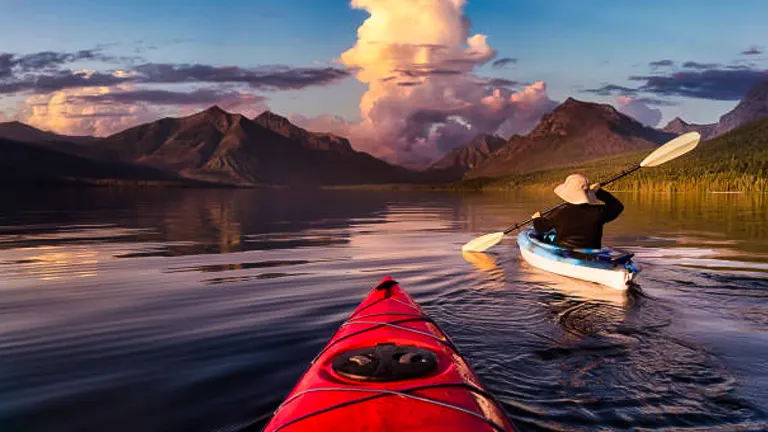
From serene, hidden waterways to the vibrant rush of expansive rivers, this guide promises to inspire and excite. Let’s embark on a journey through these unparalleled destinations, discovering the unique charm and adventure they offer.
List of 10 Best Kayaking Spots in U.S for 2024
- Glacier Bay, Alaska
- Apostle Islands National Lakeshore, Wisconsin
- Everglades National Park, Florida
- Lake Powell, Arizona/Utah
- Boundary Waters Canoe Area Wilderness, Minnesota
- Chesapeake Bay, Maryland/Virginia
- Green River, Utah
- Salton Sea, California
- Suwannee River, Florida
- Columbia River Gorge, Oregon/Washington
The Criteria for Selection
Choosing the best kayaking spots involves more than pinpointing beautiful locations on a map. Our selection is based on a comprehensive set of criteria to ensure a fulfilling experience for kayakers of all levels. We considered factors such as scenic beauty, water conditions, accessibility, and the presence of unique natural features. Expert opinions from seasoned kayakers and local enthusiasts also played a crucial role in our recommendations, guaranteeing spots that offer not just beauty but also safety and convenience.
Map Your Paddles – An Overview of U.S. Kayaking Regions
The U.S. is blessed with a rich variety of kayaking regions, each offering distinct experiences. From the serene lakes nestled in the Northeast’s forests to the rugged coastlines of the West, kayakers can find spots that suit their skill level and adventure spirit. This guide spans across these regions, showcasing spots renowned for their clear waters, abundant wildlife, and breathtaking landscapes.
10 Best Kayaking Spots in U.S for 2024
1. Glacier Bay, Alaska
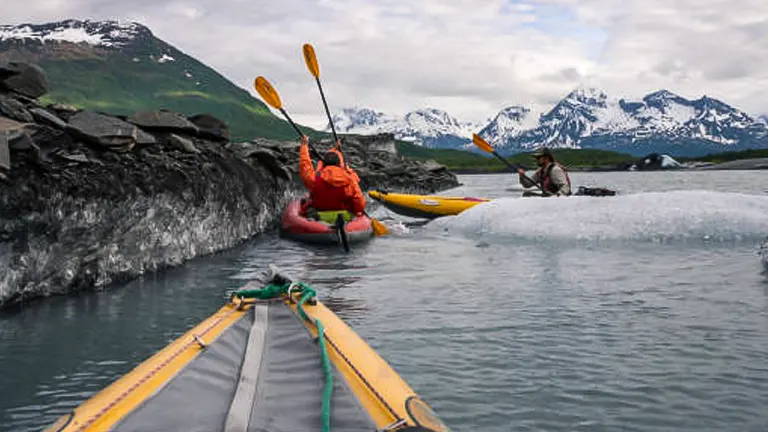
Glacier Bay in Alaska is a kayaker’s paradise, offering a surreal paddling experience amidst towering glaciers, deep fjords, and pristine waters. The bay, part of a vast national park accessible by air or sea from Juneau, is a haven for those seeking both adventure and tranquility. Kayakers here navigate through icy waters, occasionally accompanied by the sight of a glacier calving or a whale surfacing nearby. The stark beauty of the landscape, where mountains meet the sea, and the chance to encounter diverse wildlife, from seals to bald eagles, make every trip unforgettable. The remoteness of Glacier Bay adds to its allure, offering a sense of solitude and connection with nature that is increasingly rare.
- Scenic Beauty: Majestic glaciers and rugged mountain landscapes.
- Adventure Level: Medium to high, with conditions varying by area.
- Wildlife Encounters: Frequent sightings of marine mammals and birds.
- Facilities: Limited; preparation and self-sufficiency required.
- Conservation: Part of a UNESCO World Heritage Site and Biosphere Reserve.
- Best Time to Visit: Mid-June to early September for milder weather and wildlife activity.
- Access: Via Juneau, with air and water transport options to the park.
- Rental Fee Range: Guided tours start from approximately $100 USD, varying by duration and package.
2. Apostle Islands National Lakeshore, Wisconsin

The Apostle Islands National Lakeshore in Wisconsin is a kayaking destination like no other, famed for its crystal-clear waters, intricate sea caves, and historic lighthouses. Spread across Lake Superior’s southern shore, the area encompasses 21 islands and a portion of the mainland, offering diverse kayaking experiences. The calm waters near the shore make it an ideal spot for beginners, while the open waters offer challenges for the more experienced. The highlight for many is paddling through the sea caves, where water and wind have sculpted the sandstone into breathtaking formations. Beyond the natural beauty, the Apostle Islands are steeped in history, from ancient indigenous cultures to the stories of shipwrecks that lie beneath the lake’s surface.
- Scenic Beauty: Crystal-clear waters and stunning sea caves.
- Adventure Level: Suitable for all skill levels, with areas for both calm and challenging paddling.
- Cultural Heritage: Rich indigenous history and historic lighthouses.
- Facilities: Campsites on islands, kayak rentals, and guided tours available.
- Conservation: Efforts in place to protect the area’s natural and cultural resources.
- Best Time to Visit: Late spring to early fall, with peak conditions in July and August.
- Access: Accessible by car to Bayfield, WI, followed by boat or kayak to the islands.
- Rental Fee Range: Kayak rentals and tours range from $50 to $100 USD per day, depending on services offered.
3. Everglades National Park, Florida
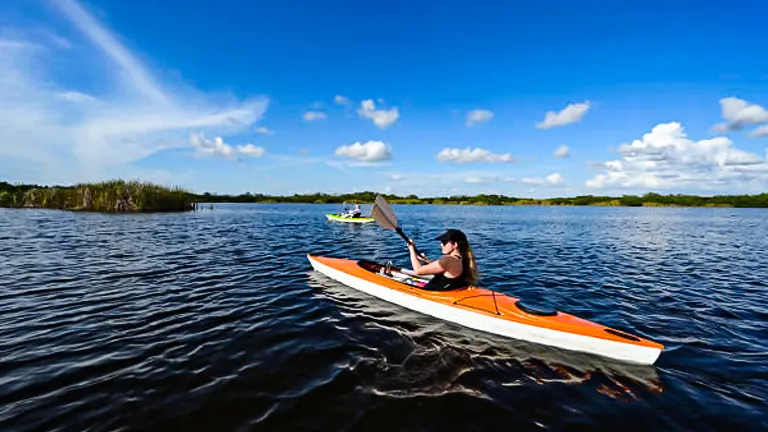
Everglades National Park in Florida presents a kayaking experience unmatched anywhere else, offering paddlers the chance to glide through the largest tropical wilderness of any kind in the U.S. This expansive area of wetlands provides a labyrinth of waterways that lead adventurers through mangrove forests, sawgrass marshes, and open bays. The Everglades are home to an array of wildlife, including the American alligator, manatees, and countless bird species, making every paddle an opportunity for close encounters with nature. The park’s diverse ecosystems allow for a variety of kayaking experiences, from short, leisurely paddles to multi-day expeditions. The Everglades’ importance as a habitat for numerous rare and endangered species has made its conservation a priority, adding to the allure for those seeking to explore one of the world’s most unique natural environments.
- Scenic Beauty: Vast wetlands and rich biodiversity.
- Adventure Level: Ranges from beginner to advanced, with endless exploration possibilities.
- Wildlife Encounters: High likelihood of sighting alligators, manatees, and exotic birds.
- Facilities: Campsites accessible by kayak, canoe rentals, and guided tour options.
- Conservation: Critical efforts underway to protect its fragile ecosystems.
- Best Time to Visit: December to April, when the weather is cooler and mosquitoes are less prevalent.
- Access: Multiple entrances, with the main visitor center in Homestead, FL.
- Rental Fee Range: Canoe and kayak rentals start around $20 USD for a half-day.
4. Lake Powell, Arizona/Utah
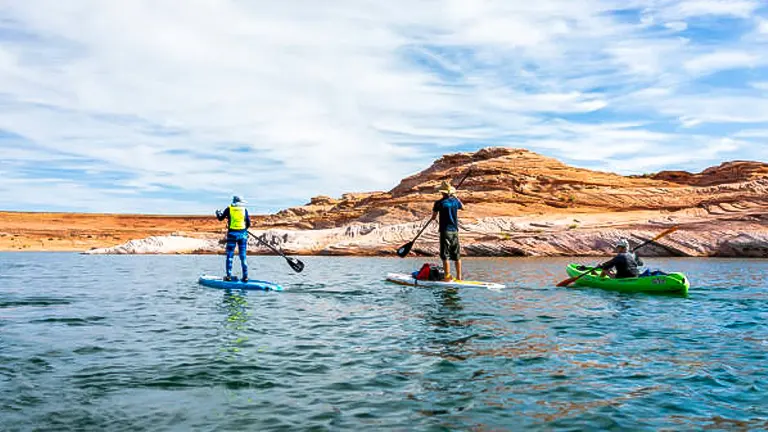
Straddling the border between Arizona and Utah, Lake Powell offers kayakers a striking contrast of deep blue waters against a backdrop of towering red rock canyons. This man-made reservoir, created by the damming of the Colorado River, has become a favored destination for its scenic beauty and the unique opportunity to paddle through narrow slot canyons. The lake’s extensive shoreline, dotted with hidden coves and secluded beaches, provides plenty of opportunities for exploration and solitude. Kayaking at Lake Powell is not just about the physical journey; it’s an immersive experience that connects paddlers with the awe-inspiring power of nature’s artistry. With over 2,000 miles of shoreline to explore, adventurers can find both serenity and thrill in these waters, making it an ideal destination for paddlers seeking both relaxation and adventure.
- Scenic Beauty: Dramatic red rock formations and crystal-clear waters.
- Adventure Level: Suitable for all levels, with areas of calm waters and more challenging routes.
- Geological Wonders: Unique slot canyons accessible only by water.
- Facilities: Ample camping spots, boat rentals, and guided kayaking tours.
- Conservation: Efforts to maintain water levels and protect the natural environment.
- Best Time to Visit: Spring (March to June) and Fall (September to November) for the best weather and water conditions.
- Access: Wahweap, Antelope Point, and Bullfrog marinas offer the most direct access to kayaking spots.
- Rental Fee Range: Kayak rentals vary from $40 to $100 per day, with options for guided tours.
5. Boundary Waters Canoe Area Wilderness, Minnesota
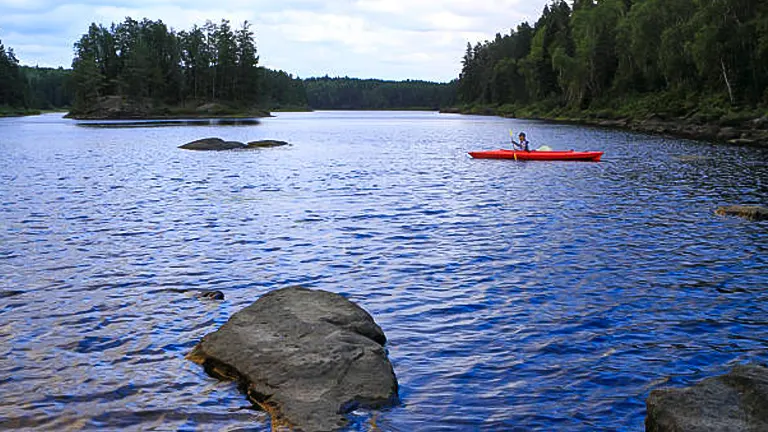
The Boundary Waters Canoe Area Wilderness (BWCAW) in Minnesota is a premier destination for kayakers seeking solitude and immersion in pristine wilderness. This vast network of waterways stretches over a million acres, bordering Canada’s Quetico Provincial Park. With over 1,200 miles of canoe routes, countless lakes, and rivers framed by dense forests, the BWCAW offers an unparalleled back-to-nature experience. Paddlers can explore serene lakes reflecting the sky, navigate quiet rivers, and portage between waterways to discover secluded spots. The area is a haven for wildlife, including moose, beavers, and eagles, enhancing the sense of being truly away from it all. The BWCAW’s emphasis on conservation and low-impact camping makes it a model for responsible outdoor recreation, preserving its beauty for future generations of adventurers.
- Scenic Beauty: Crystal-clear lakes and vast forest landscapes.
- Adventure Level: Suitable for all skill levels, with a range of easy to challenging routes.
- Wildlife Watching: High chances of encountering moose, beavers, and various bird species.
- Facilities: Numerous entry points, with permits required for overnight stays.
- Conservation: Strict regulations to preserve the wilderness experience.
- Best Time to Visit: Late spring to early fall, with July and August being the most popular months.
- Access: Entry points scattered around the perimeter, with Ely, MN, serving as a common gateway.
- Rental Fee Range: Canoe and kayak rental fees vary, starting at around $30 USD per day.
6. Chesapeake Bay, Maryland/Virginia
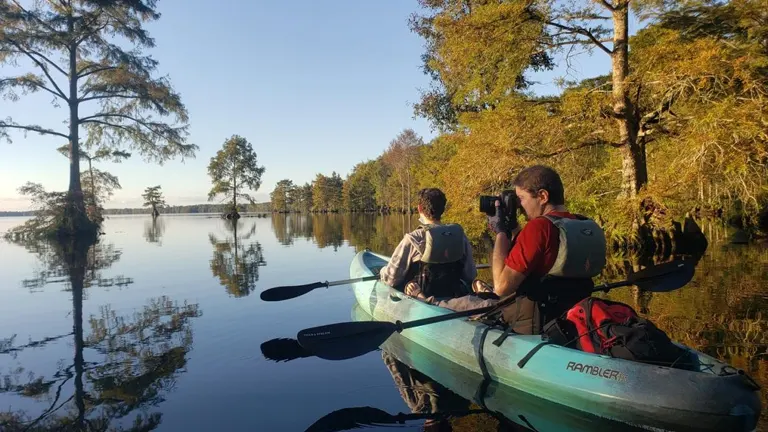
Chesapeake Bay, the largest estuary in the United States, offers kayakers a rich tapestry of experiences, from tranquil paddles through quiet marshes to exploring historic waterfront communities. Stretching across Maryland and Virginia, the bay’s waters are dotted with islands and surrounded by miles of shoreline, providing diverse habitats for wildlife and a variety of paddling environments. Kayakers can explore secluded coves, navigate past working oyster boats, and even paddle up to historic sites and lighthouses. The bay’s importance to the region’s ecology, history, and culture makes it a fascinating destination for those interested in more than just the physical act of paddling. Efforts to restore and protect the bay’s health offer hope for the sustainability of its natural and cultural resources, adding an educational dimension to kayaking adventures here.
- Scenic Beauty: Diverse waterways with rich maritime history.
- Adventure Level: Varied, offering calm waters for beginners and open areas for more experienced kayakers.
- Cultural Exploration: Opportunities to learn about the bay’s history and visit historic sites.
- Facilities: Wide range of access points, with kayak rentals and tours available.
- Conservation: Ongoing restoration efforts to improve water quality and habitat.
- Best Time to Visit: Spring through fall, with peak wildlife activity in the spring and early summer.
- Access: Numerous public access points along both the Maryland and Virginia shores.
- Rental Fee Range: Kayak rentals and tours starting at around $40 USD, with prices varying by location and tour length.
7. Green River, Utah
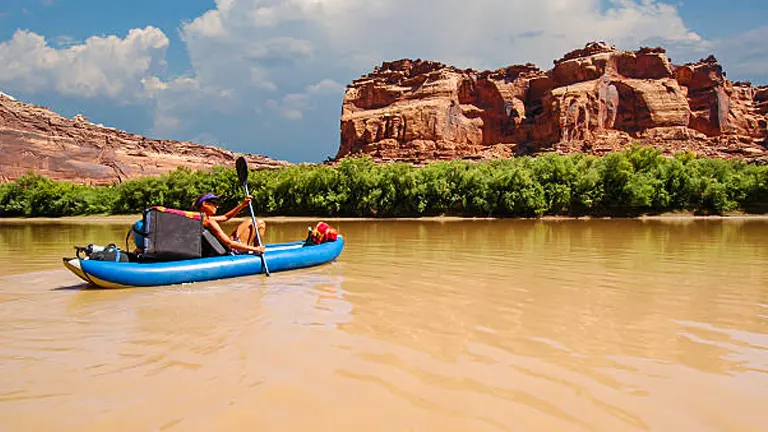
The Green River in Utah carves its way through some of the most spectacular desert landscapes in the American Southwest, offering kayakers an unforgettable journey through deep canyons and tranquil waters. This river stretches for hundreds of miles, providing diverse paddling experiences that range from calm, easy stretches ideal for beginners, to more challenging whitewater sections suited for experienced adventurers. The journey through the Green River often starts in the town of Green River, Utah, before winding through Labyrinth and Stillwater Canyons, offering paddlers breathtaking views of towering red rock formations and ancient Native American rock art. This area’s remote nature promises a true off-the-grid adventure, where kayakers can camp under star-filled skies and disconnect from the modern world.
- Scenic Beauty: Dramatic desert canyons and serene river stretches.
- Adventure Level: Varied, with sections for all skill levels.
- Historical Significance: Abundant Native American petroglyphs and historical sites.
- Facilities: Primitive; preparedness for self-sufficiency is essential.
- Conservation: Efforts focus on preserving the river’s natural beauty and archaeological sites.
- Best Time to Visit: Spring (April to June) and Fall (September to November) for milder weather and optimal water levels.
- Access: Primary access through Green River, Utah, with various put-in and take-out points along the river.
- Rental Fee Range: Rental and shuttle services vary, with complete outfitting packages starting around $75 per day.
8. Salton Sea, California
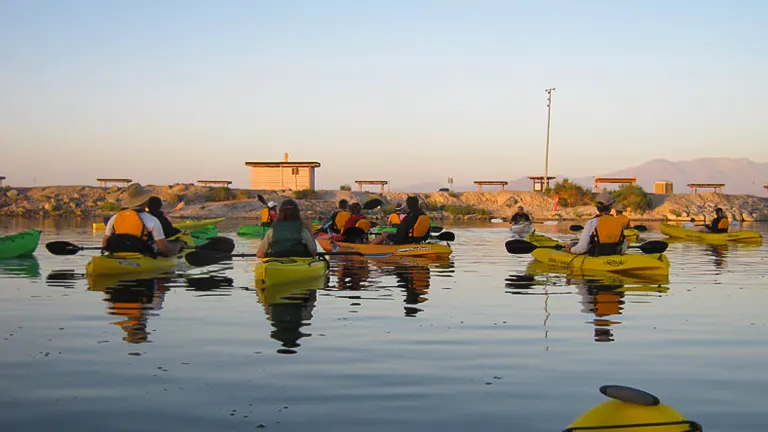
The Salton Sea in California presents a unique kayaking experience steeped in both natural beauty and poignant history. As the largest lake in California, it offers expansive waterways surrounded by desert and mountains, creating stunning vistas. However, the Salton Sea is also a site of ecological significance, facing challenges of water level fluctuations and salinity increases that have impacted the local wildlife and habitat. Kayaking here not only allows for exploration of its eerie, beautiful landscapes but also serves as an educational experience on environmental issues. Paddlers can explore abandoned structures half-submerged in water and visit bird sanctuaries, making it a journey through both natural wonders and remnants of human ambition.
- Scenic Beauty: Unique desert lake with intriguing, surreal landscapes.
- Adventure Level: Easy, suitable for paddlers of all skill levels.
- Environmental Insight: Offers a firsthand look at ecological challenges and conservation efforts.
- Facilities: Limited facilities; preparation is key.
- Conservation: Significant bird habitat with ongoing restoration efforts.
- Best Time to Visit: Late fall to early spring, to avoid the extreme summer heat.
- Access: Easily accessible from surrounding areas, with state highways providing close access.
- Rental Fee Range: Limited rental options; visitors may need to bring their own equipment.
9. Suwannee River, Florida
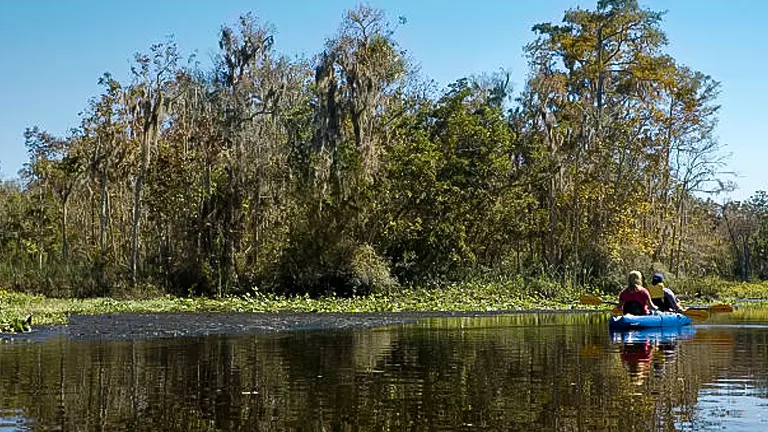
The Suwannee River, winding its way through South Georgia and North Florida to the Gulf of Mexico, offers a rich tapestry of cypress forests, spring-fed pools, and a sprawling network of wildlife habitats. This historic river, immortalized in song, presents kayakers with over 200 miles of scenic waterways that invite exploration. Paddlers on the Suwannee can enjoy tranquil waters, encounter abundant wildlife, including manatees in the cooler months, and discover the unique cultural heritage of the region. The river’s banks are dotted with state parks, springs, and quaint towns, offering numerous opportunities for rest and exploration. The Suwannee’s significance goes beyond its natural beauty, serving as a crucial habitat for diverse species and a source of inspiration for conservation efforts.
- Scenic Beauty: Lush cypress forests and clear, spring-fed waters.
- Adventure Level: Generally easy to moderate, with sections suitable for all abilities.
- Wildlife Encounters: Rich in biodiversity, with opportunities to see manatees, otters, and numerous bird species.
- Facilities: Well-equipped state parks and campgrounds along the route.
- Conservation: Ongoing efforts to protect the river’s ecosystems and water quality.
- Best Time to Visit: Fall to spring, with cooler temperatures and optimal wildlife viewing.
- Access: Multiple access points along its course, with popular launches near White Springs, FL.
- Rental Fee Range: Kayak rentals and shuttle services available, with prices starting around $50 for a day trip.
10. Columbia River Gorge, Oregon/Washington
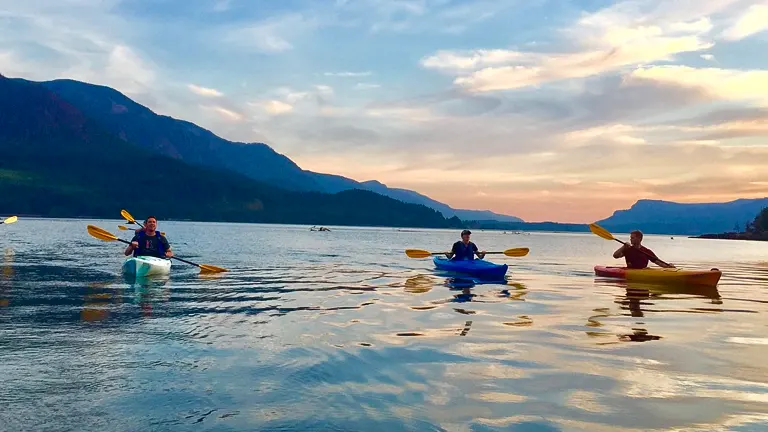
Straddling the border between Oregon and Washington, the Columbia River Gorge is a majestic and wind-swept canyon that cuts through the Cascade Range, forming the boundary between the two states. The gorge offers kayakers a mix of tranquil waters in sheltered areas and challenging conditions in the more exposed sections, making it a versatile destination for paddlers of all skill levels. The Columbia River is renowned for its stunning waterfalls, including the iconic Multnomah Falls, ancient basalt cliffs, and verdant forests that provide a breathtaking backdrop for kayaking adventures. This area is not only a paradise for paddlers but also a hub for wind sports, thanks to the strong winds funneling through the gorge, adding an extra layer of excitement for those on the water.
- Scenic Beauty: Dramatic canyon views, cascading waterfalls, and lush forests.
- Adventure Level: Ranges from calm waters perfect for beginners to challenging windy sections for experienced kayakers.
- Historical Landmarks: Rich in Native American and pioneer history, with numerous cultural sites along its banks.
- Facilities: Multiple launch sites, with kayak rentals and guided tours available in nearby towns.
- Conservation: Protected area efforts focus on preserving natural beauty and supporting wildlife.
- Best Time to Visit: Late spring through early fall, for the most pleasant weather and water conditions.
- Access: Accessible from both the Oregon and Washington sides, with popular spots near Hood River, OR.
- Rental Fee Range: Varies, with options for half-day rentals starting at about $40, extending to multi-day expedition packages.
Essential Kayaking Gear for 2024
Before you start on your 2024 kayaking adventure, equipping yourself with the right gear is crucial for both safety and enjoyment. Essential kayaking gear includes:
- Kayak: Choose one that suits your activity level and the nature of the water you’ll be exploring. Sit-on-top kayaks are great for beginners and warm environments, while sea kayaks are better suited for longer, more challenging journeys.
- Paddle: Lightweight and durable paddles reduce fatigue and increase maneuverability. The size and shape should match your size and paddling style.
- Personal Flotation Device (PFD): A must-have for safety, ensure your PFD fits well and is appropriate for the type of kayaking you’re doing.
- Helmet: Essential for whitewater kayaking and advisable in other challenging conditions.
- Dry Bag: Protect your essentials from water with a reliable dry bag, especially important for longer expeditions.
- Appropriate Clothing: Wear layers that can easily adjust to changing conditions and materials that dry quickly, such as synthetic fabrics or wool.
Key Safety Tips
Safety should always be a top priority when kayaking. Here are key tips to keep in mind:
- Always Wear a Life Jacket: Regardless of your swimming ability, a life jacket is your best safety tool on the water.
- Check the Weather: Before setting out, always check the weather forecast and water conditions. Be prepared to postpone if conditions are unfavorable.
- Plan Your Route: Know where you’re going and how long it should take. Inform someone of your plan and expected return time.
- Stay Hydrated and Protected: Bring enough water and use sun protection, including sunscreen, hats, and sunglasses.
- Know Your Limits: Paddle within your ability level. If you’re trying a more challenging spot, consider going with a guide or an experienced group.
Maximizing Your Kayaking Adventure
To make the most of your kayaking experience in 2024, consider these tips:
- Photography and Wildlife Observation: Kayaks provide a stable platform for photography and observing wildlife. Bring a waterproof camera and binoculars to capture the moments and sights.
- Fishing: Many kayakers enjoy the added challenge and relaxation of fishing from their kayak. Ensure you have the appropriate gear and permits.
- Leave No Trace: Respect the natural environment by following Leave No Trace principles. This ensures the preservation of these beautiful spots for future kayakers.
- Join a Kayaking Group or Club: Connecting with fellow kayakers can enhance your experiences, provide opportunities to learn, and offer safety in numbers for more challenging adventures.
Related Post
- Explore the Top 15 Must-See Hiking Trails in Colorado for 2024: Your Ultimate Guide
- Discover the Top 15 World’s Most Spectacular Waterfalls: The Ultimate Traveler’s Bucket List
- Discover the Top 12 Mountain Bike Trails in Michigan for 2024: Ultimate Riders’ Guide
- 11 Best Horseback Riding Locations in the USA for 2024: The Ultimate Guide
- Explore the Top 12 State Parks in Alaska for 2024: Your Expert Guide
- Top 10 Camping Sites in Arizona You Need to Visit in 2024: Your Ultimate Outdoor Guide
- Discover the Top 20 World-Class Hiking Adventures in 2024
- Top 10 Most Spectacular Kayaking Spots in Texas: Must-Visit Destinations
Conclusion
As we venture into 2024, the diverse and breathtaking kayaking spots across the U.S. promise adventures that cater to every paddler’s dream. From serene rivers to dramatic coastlines, these destinations offer more than just a journey through water—they provide a passage to self-discovery, a deeper connection with nature, and a vivid reminder of the importance of preserving our natural world. Let’s embrace these adventures with respect for the environment and an unwavering commitment to safety, ensuring these treasures remain for future generations to explore and cherish.
FAQs
- What makes the 2024 list of best kayaking spots in the U.S. stand out?
The 2024 list is curated based on a blend of expert opinions, ecological significance, and the variety of experiences offered. From serene lakes to challenging rivers, each spot has been selected for its unique beauty, wildlife opportunities, and accessibility for kayakers of all skill levels. - Are there any new entries on the 2024 list compared to previous years?
Yes, the 2024 list includes new entries that have gained popularity due to their conservation efforts, improved access for kayakers, and enhanced visitor experiences. These spots have been recognized for offering unique kayaking adventures and commitment to preserving natural beauty. - How do I choose the right kayaking spot for my skill level?
Consider the type of water (calm lakes vs. flowing rivers), the presence of guided tours, and the availability of rental equipment. Beginners may prefer calm, flat waters with rental and instruction available, while experienced kayakers might seek out more challenging, remote waters. - What preparations are necessary for kayaking in these top spots?
Preparation should include checking weather conditions, securing necessary permits or reservations, packing appropriate safety gear and supplies, and familiarizing yourself with the local regulations and conservation practices to ensure a safe and respectful visit. - Can I find guided tours in these top kayaking destinations?
Yes, many of the top kayaking destinations offer guided tours. These tours are a great way to safely explore unfamiliar waters, learn about the local ecology and history, and even pick up kayaking tips from experienced guides. - What is the best time of year to visit these kayaking spots?
The best time varies by location, depending on weather, water levels, and wildlife activity. Generally, late spring to early fall is ideal for most destinations, but some, like those in warmer climates, offer year-round kayaking opportunities. - Are there any kid-friendly kayaking spots on the 2024 list?
Absolutely! Several spots on the list cater to families and younger paddlers, offering calm waters, short routes, and plenty of scenic stops. Look for destinations with flatwater kayaking and nearby outdoor activities to ensure a fun and safe experience for all ages. - How are conservation and environmental protection efforts considered in selecting the top spots?
Conservation efforts are a key factor in the selection process. Spots that implement sustainable practices, support wildlife preservation, and encourage eco-friendly tourism are prioritized to promote responsible kayaking adventures that contribute to the protection of natural resources.
We’re eager to hear about your adventures in the top kayaking spots across the U.S. for 2024! Share your stories, insights, and unforgettable moments with us. Together, let’s embrace the excitement of paddling and our dedication to protecting the stunning scenery that makes these experiences so remarkable.
Explore our dedicated section on national forests and state parks to uncover hidden gems and outdoor wonders.

Benjamin Brooks
Forestry AuthorGreetings! I'm Benjamin Brooks, and my journey over the past 15 years has revolved around the fascinating realms of content creation, expertise in snow clearing, and the intricate world of lumberjacking and landscaping. What began as a simple curiosity about the natural world and heavy machinery has evolved into a passionate profession where my love for crafting words intertwines seamlessly with my lumberjacking and garden skills.


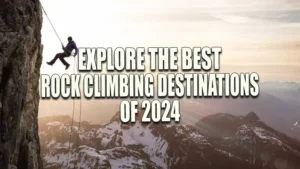



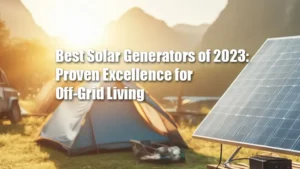






Leave your comment